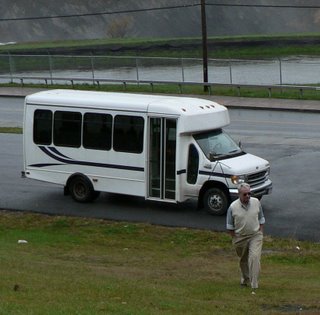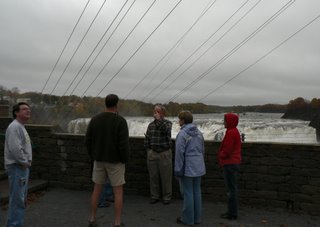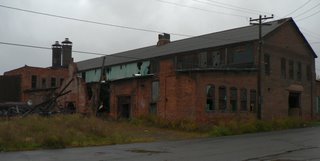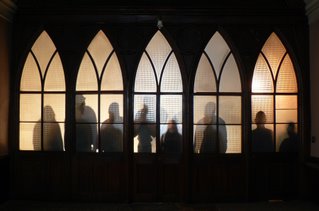On October 28th, students, alumni, and faculty traveled to Hyde Park, New York, to participate in another conference, Preservation Under Pressure: Protecting Historic Community Character in a Time of Change, sponsored by the Preservation League of New York State, Hudson River Heritage, and the National Trust for Historic Preservation (as described below).
Held at the new Henry A. Wallace Visitor and Education Center, designed by the architect Frances Halsband, the conference brought together a diverse group of preservationists, elected officials, planners, planning and zoning board members and staff, and others.
Tuesday, October 31, 2006
Sunday, October 29, 2006
A Busy Weekend Away From School, Part I
On October 27th, students, alumni, and faculty took advantage of a free weekend to attend and participate in two excellent conferences: the Louis Sullivan Terra Cotta Symposium and Preservation Under Pressure.
Organized by the Northeast Chapter of the Association for Preservation Technology in association with Wank Adams Slavin Associates (WASA) and Cooper Union, the Louis Sullivan Terra Cotta Symposium commemorated 150 years since the birth of the architect Louis Sullivan. Presentations focused on the technology and early manufacturing period of terra cotta in the United States from the 1850s onward; Louis Sullivan's role in the evolution, development, and use of terra cotta throughout the 20th century; and the continuing evolution of conservation practice and techniques for the care of terra cotta today. The symposium was held at Cooper Union, one of the oldest known structures in the United States using terra cotta.
Building Conservation professor and consulting engineer Donald Friedman presented "Terra Cotta As Structure." Other presentations and speakers included:
Organized by the Northeast Chapter of the Association for Preservation Technology in association with Wank Adams Slavin Associates (WASA) and Cooper Union, the Louis Sullivan Terra Cotta Symposium commemorated 150 years since the birth of the architect Louis Sullivan. Presentations focused on the technology and early manufacturing period of terra cotta in the United States from the 1850s onward; Louis Sullivan's role in the evolution, development, and use of terra cotta throughout the 20th century; and the continuing evolution of conservation practice and techniques for the care of terra cotta today. The symposium was held at Cooper Union, one of the oldest known structures in the United States using terra cotta.
Building Conservation professor and consulting engineer Donald Friedman presented "Terra Cotta As Structure." Other presentations and speakers included:
- "Growing Up Together: Louis Sullivan and the United States Terra Cotta Industry" by Tim Samuelson, Cultural Historian for Chicago Department of Cultural Affairs
- "Terra Cotta: Its Evolving Technology & Unique Application" by Susan Tunick, Friends of Terra Cotta
- "Louis Sullivan at the Metropolitan Museum of Art" by Morrison H. Heckscher, Lawrence A. Fleischman Chairman of the American Wing Metropolitan Museum of Art
- "Angels Repaired: The Bayard-Condict Building" by Stephen Gottlieb and Norman Weiss (both formerly with WASA)
- "Terra Cotta: The Numbers Game" by Michael Y. Ahearn, Seaboard Weatherproofing & Restoration Company
- "The Recrowning of Louis Sullivan's Carson Pirie Scott & Company Store" by Gunny Harboe, Harboe Architects
- "Cleaning Terra Cotta in the New York City Subway Stations: Making Informed Choices" by Mary Jablonski, Jablonski Berkowitz Conservation
- "Terra Cotta Restoration: Where We Are and Where We Are Going" by Stephen Kelley, Wiss, Janney, Elstner Associates
- "Blackfriar's House in London: Cathodic Protection of Carraware in the United Kingdom" by Paul Noyce and Peter Gibbs, Electro Tech
Monday, October 23, 2006
Friday Night Lights: Daisy Baker's Restaurant

While perhaps not quite as exciting as attending football games, our Friday night evening sessions are a highlight and very important part of the Building Conservation program. Generally speaking, this required course time, usually 5:00 to 8:00 p.m., is used as supplemental class time or time to tour a specific historic site, professional office, or project. However the time is used, it always includes dinner and involves both students and faculty.
In some cases, dinner is catered in and class work (such as during Preservation Design Studio in spring semester) continues or we hear from a guest speaker such as a local preservation architect, representative of the state historic preservation office, or stained glass conservation consultant. At other times, usually when we visit a specific site or office, students and faculty travel to the designated place and either have a catered dinner there or dine at a local restaurant with historic character (and, of course, good food).
The Friday night sessions enable the students to get to know one another, and facilitate close interaction between students, faculty, invited guests, friends of the program, and other professionals in the field. They also help establish a teamwork and collaboration orientation, rather than the competitive orientation of so many academic programs.
In past years, we have visited the offices of Mesick Cohen Wilson Baker Architects; John G. Waite Architects; Einhorn Yaffee Prescott; River Street Planning & Development; the New York State Office of Parks, Recreation and Historic Preservation; New York State Capitol; New York State Education Building; the Gardner Earl Chapel and Oakwood Cemetery; the city of Troy's Washington Park and Pottery District neighborhoods, and many other places.
Restaurants have included Smiths in Cohoes, New York; Brown's Brewing Company/Revolution Hall, Holmes & Watson, and South End Tavern in Troy, New York; and the Pump Station and Franklin's Tower in Albany.
This week, the Friday night session was mainly social. Faculty and students met at the historic Daisy Baker's Restaurant, a Richardson Romanesque building originally constructed as Troy's YWCA.
Industrial Archeology in Troy, Waterford, and Cohoes, New York
This weekend's classes included Industrial Archeology, Building Conservation, Economics of Historic Preservation, and Materials Testing.
The Industrial Archeology class toured historic industrial buildings and sites in Troy, Waterford, and Cohoes, New York. Traveling in a Rensselaer shuttle bus driven by program director Frederick Cawley, the group learned about the Hudson-Mohawk region's industrial heritage, with narration by adjunct professor P. Thomas Carroll, who is also executive director of the Hudson Mohawk Industrial Gateway and the RiverSpark Heritage Area.


Highlights of the tour included the Cohoes Falls, Gas Holder House, Ludlow Valve, Woodside Church, and various remaining structures of the Burden Iron Works Company, the Poestenkill Gorge, several locks of the Erie and Champlain Canals.



The Industrial Archeology class toured historic industrial buildings and sites in Troy, Waterford, and Cohoes, New York. Traveling in a Rensselaer shuttle bus driven by program director Frederick Cawley, the group learned about the Hudson-Mohawk region's industrial heritage, with narration by adjunct professor P. Thomas Carroll, who is also executive director of the Hudson Mohawk Industrial Gateway and the RiverSpark Heritage Area.


Highlights of the tour included the Cohoes Falls, Gas Holder House, Ludlow Valve, Woodside Church, and various remaining structures of the Burden Iron Works Company, the Poestenkill Gorge, several locks of the Erie and Champlain Canals.



Monday, October 16, 2006
Historic Preservation Conference, October 28, 2006
On October 28th, several Building Conservation program faculty and students will be traveling to Hyde Park, New York, to attend the conference "Preservation Under Pressure: Protecting Historic Community Character in a Time of Change." The conference is co-sponsored by the Preservation League of New York State, Hudson River Heritage, and the National Trust for Historic Preservation.
The conference is titled Preservation Under Pressure: Protecting Historic Community Character in a Time of Change. Speakers and topics include:
Edward T. McMahon: Dollars and Sense of Preserving Community Character
J. Winthrop Aldrich: Terra Firma: Preserving the Heritage and Natural Landscape of the Hudson Valley
Geoff Bornemann: Design Considerations and Community Character
Paul Daniel Marriott: Empire Roads: Historic and Scenic Road Protection in New York State
Sally Mazzarella: Blending Diversified Planning Tools to Implement A Community's Vision
The conference has been approved for six hours of local continuing education credit by the New York Upstate Chapter of the American Planning Association. For more information, visit www.preservenys.org or call (518) 462-5658, x. 13.
The conference is titled Preservation Under Pressure: Protecting Historic Community Character in a Time of Change. Speakers and topics include:
Edward T. McMahon: Dollars and Sense of Preserving Community Character
J. Winthrop Aldrich: Terra Firma: Preserving the Heritage and Natural Landscape of the Hudson Valley
Geoff Bornemann: Design Considerations and Community Character
Paul Daniel Marriott: Empire Roads: Historic and Scenic Road Protection in New York State
Sally Mazzarella: Blending Diversified Planning Tools to Implement A Community's Vision
The conference has been approved for six hours of local continuing education credit by the New York Upstate Chapter of the American Planning Association. For more information, visit www.preservenys.org or call (518) 462-5658, x. 13.
Sunday, October 08, 2006
Van Alen House Archeology
Yesterday's archeology class exposed students to the methodology and process of an archeological dig at the eighteenth century John Evert van Alen House in DeFreestville, New York.

Small teams of students did shovel test pit excavations under the tutelage of professional archeologists. Correct procedure, nomenclature and recording were emphasized. The afternoon session was held at the Hartgen Archeological Associates' nearby lab. Students separated, cleaned and analyzed the artifacts they had found. Discussion followed as to what possibilities might be indicated by the results.

Small teams of students did shovel test pit excavations under the tutelage of professional archeologists. Correct procedure, nomenclature and recording were emphasized. The afternoon session was held at the Hartgen Archeological Associates' nearby lab. Students separated, cleaned and analyzed the artifacts they had found. Discussion followed as to what possibilities might be indicated by the results.
Friday, October 06, 2006
EMPAC Construction Site Tour
Following Economics of Historic Preservation in the morning, lunch in the Greene building, and Building Conservation I and II in the afternoon, Building Conservation program students and faculty toured the construction site of Rensselaer's new Experimental Media and Performing Arts Center and then gathered for a leisurely dinner at Brown's Brewing Company in historic downtown Troy, New York.

The Economics class focused on downtown revitalization, the National Trust for Historic Preservation's Main Street program, and business improvement districts. Students submitted their case study proposals, and will be intensively studying historic preservation policy, planning, and implementation projects in Somerville, Massachusetts; Charlestown, Massachusetts; Ithaca, New York; Wellsboro and Williamsport, Pennsylvania; Syracuse, New York; Utica, New York; Burlington, Vermont; and Oswego County, New York.
The Building Conservation (20th Century Building Materials) class focused on the use of metals in construction. The 20th century saw the use of traditional metals used in new ways and the formulation of new alloys, including nickel silver, monel, weathering and stainless steels, aluminum and titanium. Their properties, uses, care, preservation, deterioration and restoration were explored and notable examples were illustrated.
As noted on Rensselaer's home page, the 220,000-square foot EMPAC will contain a wide and flexible range of major venues including an atrium; 1,200-seat concert hall; 400-seat theater; 3,500-square-foot studio; 2,500-square-foot-studio; suites for artists-in-residence; rehearsal spaces; student and support spaces; professional recording, editing and post-production facilities; and digital broadcasting facilities. EMPAC is positioned at the southwest edge of campus on a steep bluff affording spectacular views of the city of Troy and Hudson River valley.

Brown's Brewing Company exemplifies a creative and evolving example of adaptive use and neighborhood revitalization. It occupies several historic warehouse buildings along the Hudson River in a commercial neighborhood that is being revitalized. Established as one of the region's first brew pubs in 1993, Brown's initially occupied two floors of a single commercial building that the small group of owners restored. In subsequent years, the owners have continued to make improvements, adding a deep porch overlooking the Hudson River along the building's rear facade, rehabilitating fire damaged upper floors into office space, and rehabilitating an adjoining building for use as Revolution Hall, a live performance venue.

The Economics class focused on downtown revitalization, the National Trust for Historic Preservation's Main Street program, and business improvement districts. Students submitted their case study proposals, and will be intensively studying historic preservation policy, planning, and implementation projects in Somerville, Massachusetts; Charlestown, Massachusetts; Ithaca, New York; Wellsboro and Williamsport, Pennsylvania; Syracuse, New York; Utica, New York; Burlington, Vermont; and Oswego County, New York.
The Building Conservation (20th Century Building Materials) class focused on the use of metals in construction. The 20th century saw the use of traditional metals used in new ways and the formulation of new alloys, including nickel silver, monel, weathering and stainless steels, aluminum and titanium. Their properties, uses, care, preservation, deterioration and restoration were explored and notable examples were illustrated.
As noted on Rensselaer's home page, the 220,000-square foot EMPAC will contain a wide and flexible range of major venues including an atrium; 1,200-seat concert hall; 400-seat theater; 3,500-square-foot studio; 2,500-square-foot-studio; suites for artists-in-residence; rehearsal spaces; student and support spaces; professional recording, editing and post-production facilities; and digital broadcasting facilities. EMPAC is positioned at the southwest edge of campus on a steep bluff affording spectacular views of the city of Troy and Hudson River valley.

Brown's Brewing Company exemplifies a creative and evolving example of adaptive use and neighborhood revitalization. It occupies several historic warehouse buildings along the Hudson River in a commercial neighborhood that is being revitalized. Established as one of the region's first brew pubs in 1993, Brown's initially occupied two floors of a single commercial building that the small group of owners restored. In subsequent years, the owners have continued to make improvements, adding a deep porch overlooking the Hudson River along the building's rear facade, rehabilitating fire damaged upper floors into office space, and rehabilitating an adjoining building for use as Revolution Hall, a live performance venue.
Subscribe to:
Posts (Atom)


